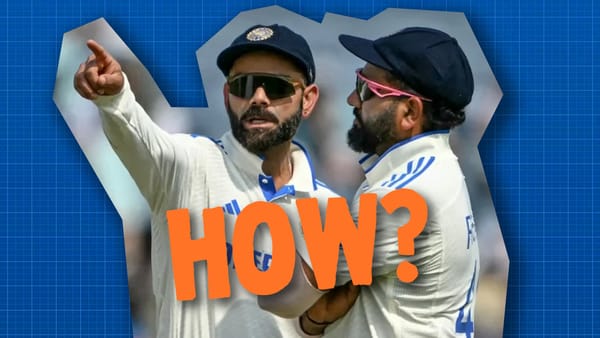Around the world
Right-arm bowlers are stalking left-handed batsmen.
"Right-arm around" is what the umpires say.

In this Test we've had 113 balls from one side; 124 from the other against left-handed batsmen from right-arm seam.
Of those 113 over the wicket, not one has been successful, of the 124, four have. Meaning around the wicket is averaging 14. That's not normal, but it does fit the trend.
This series was always going to have heaps of it, Kemar Roach and Stuart Broad are the kings of around the wicket. But today Roach took no wickets, and neither did Broad (obviously). So even without the around wicket kings, it was still happening.
I am legit obsessed with this trend.
It wasn't uncommon for bowlers to come around the wicket to certain batsmen before. Freddie Flintoff to Adam Gilchrist is one, but what was rare was a bowler doing this all the time regardless of the batsman. A few mentioned Andre Nel or Glenn McGrath as early adopters. We have a lot of numbers on Andre Nel, and most of the second part of McGrath's career. Nel and McGrath make sense as around the wickets guy, neither were outswing bowlers, they both hit the deck and could move the ball away from left-handers. Nel bowled around the wicket 51% of the time, McGrath 24%. Nel would probably only bowl around the wicket now - his average was 23 lower. McGrath was a beast from over the wicket, so probably just would've targeted batsmen as he did in his career.
But those numbers are low compared to Roach, who is at 93% over the last two years.
But the change isn't one or two guys, it's all the bowlers. Rightie seam bowlers have gone from 21% to 40% around the wicket in five years. Doubling, and in the next two years, I expect over 50% of the deliveries will be around.
Because it's working; averaging ten less than over the wicket.
But it's worth looking at the many reasons. One the physiology of bowlers has changed, when cricket had the backfoot no ball law, outswing bowling was the significant skill at the top level. Now there are virtually no outswing only specialists left. West Indies in the 80s and Australia in the 90s, changed what bowlers looked like. They got taller, stronger, and hit the deck more, meaning less swing. If you're bowling outswing (or inswing to a leftie) you need to be over the wicket. If you don't, you're better off around.
Then there is the professionalism of modern cricketers. It's getting harder for bowlers to state a preference. Coaches push players to try both, and if there is a team plan, you can't say I don't want to. Since my career started, I've seen so much more around the wicket bowling in the nets.
And there are more plans on this because there are more people like me in cricket. We're looking it up and feeding back information. I chatted to one T20 bowler about this as he had a poor record against left-handers. The next few games he moved around, and he was holding his own or even dominating them.
Batting pros would have grown up without being targeted over 40% of the time from right-armers around the wicket. All their movements are for right arm over, and then when they were set, and usually the ball had died down, they'd get someone around. Now they get some straight away, and they're struggling.
DRS and the way umpires look at LBWs has changed. Before the right-arm around angle would have given them doubt. Now umpires understand that you can still be out LBW from around. But the percentage of wickets right-armers take around the wicket was 10% from 02 to 07, and now it's 14%. That's a decent rise, but not enough to account for the drop in average. Plus, LBW is something you'd expect to rise if more bowlers are going up against unset batsmen with fresher balls.
So far we've not seen the same effect with left-armers bowling around the wicket to right-handed batsmen. But they already have an advantage over righties, and my guess is they try this as more of a last resort.
For the left-handers, this will get easier. As this has been a trend more at the top level of the game, now it will filter through club and underage cricket. Meaning the next generation won't be as unprepared. And at Test level, we need to be clear, wickets haven't been this friendly since 100 years ago. And this is an exceptional crop of bowlers. It's a horrendous time for all the bowlers in the world to discover a tactical advantage.
It's real genius is the angle keeps your stumps in play, and the lines keep the cordon in play. Every ball could be a bowled or LBW, unless it moves, then it's a catch behind. It's a unique thing in cricket. Off spin, but faster.
Today Jason Holder came around the wicket to Ben Stokes, because he averages 12 when he does that to lefties in the last two years. He angled the ball in; it moved away, and for a moment, I couldn't tell if he'd bowled him, had him caught behind, or it was LBW. It was 80MPH offspin from six-foot plenty. It only dismissed him once, it looked like a delivery good enough it could've taken three wickets.
Umpires call "right arm around" to batsmen when a bowler comes on, it always sounded like a defeated phrase. A sign of failure. Now it's a war cry.
For those who haven’t seen, I am doing a daily podcast with Jon Norman called Following on for the summer. You can find it in all the podcasty places.




